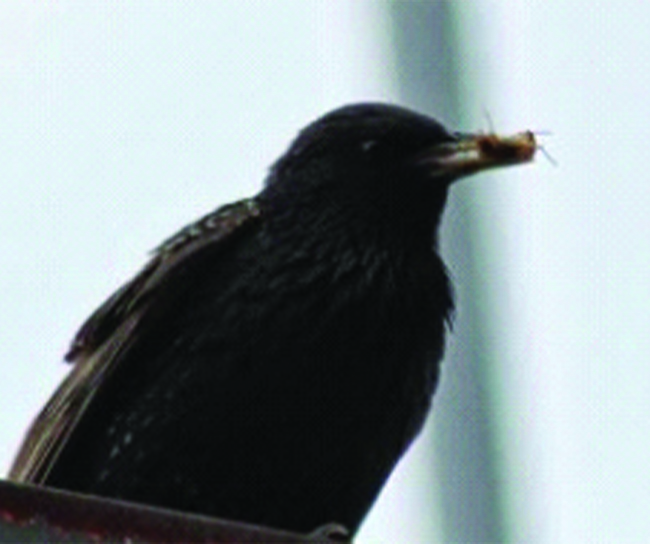Nothing signals the arrival of spring like the sounds of birds chirping and singing. However, with the arrival of spring comes the mating and birthing season for birds. This can be problematic for home or business owners if the birds decide to build their nests and lay their eggs in or on your home or business. To protect your property it helps to know the behaviours and habits of birds, so you know when to be on the lookout for birds looking to make a home on your property.
European Starlings Mating Behaviours
The appearance of starlings changes throughout the year and a particular look during the spring mating and nesting season. In winter the beaks of European Starlings are a glossy iridescent black with purple and green tones, the tips of the feathers have white stars. By spring the white feather tips have worn away, so that by the time of breeding season they are no longer noticeable.
The timing of this change seems to be geographic as some start changing as early as November while others don’t do so until January or February. Male starlings in breeding season have a blue cast to the beak and females have pink.
Starlings are infamous for stealing other birds nesting sites. They grab nest cavities and displace other cavity nesting birds such as Woodpeckers, and Purple Martins.
Males select the nest site and then females choose a male and site. Resident males start checking out nest sites in late winter, while migratory males are looking by February or March. Starlings will nest in just about any cavity (including cliffs, burrows, rock crevices and holes and gaps found on houses including, vent openings).
Males start putting nesting material in the cavity shortly after picking a site. Once they have paired off (late February through March), the pair builds the nest together, usually in the morning and evening. Sometimes the female takes out nesting material brought by the male. They may also remove nesting material (including sawdust or wood chips) from a previous nest.
A nest can be built in as little as 1-3 days. The nest is bulky and messy. The cavity is filled up with grass, weed stems, twigs, corn husks, dried leaves, pine needles, etc., with a depression near the back. Feathers, rootlets, paper, plastics, cloth, string etc. may also be added. The cup lining may include feathers, fine bark, leaves, fine grass etc. Some nests also have fresh green plants. The nest cup is about 7–8 cm in diameter and 5–8 cm deep.
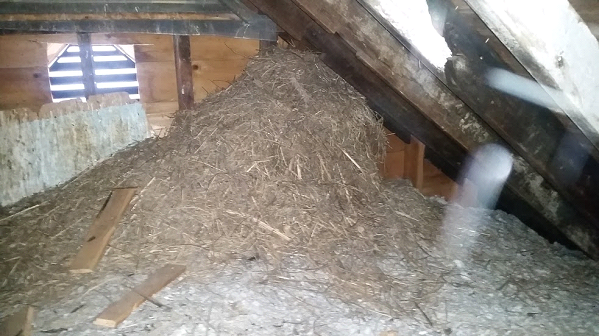
Starling nests in attics are potential fire hazards. They also block airflow from the vent above, which is important for a well ventilated attic. Starling nests may also have mites.
Starlings usually lay 4-6 eggs in mid-April. All birds within a colony start to lay eggs within a few days. The female does the majority of the incubation; the chicks hatch 12 days later.
Only the female broods the chicks, although both parents feed them. They are fed entirely on insects and their larvae, spiders and earthworms for the first 12 days, after which the diet is more varied.
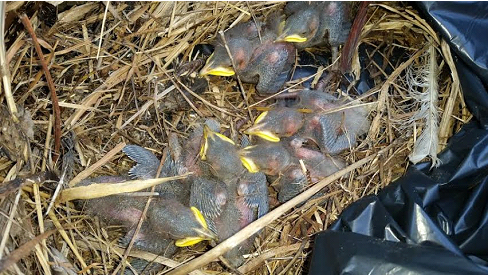
Starling chicks removed from a kitchen wall vent. The chicks will be placed in a container next to the screened vent so that their parents can continue to raise them until they are ready to fly.
If starlings decide to make their home in a chimney, vent pipe, attic, crack or on a ledge of your business, it can cause a lot of stress for the property owner.
Starlings are able to transmit ectoparasites such as mites, fleas, and bedbugs as well as diseases which are potentially fatal to humans, pets, and livestock. These diseases include Histoplasmosis, Salmonellosis, Toxoplasmosis, and Chlamydiosis.
Corrosive bird droppings can erode building finishes, causing costly and ongoing maintenance and repairs. Bird droppings can also cause unsanitary working conditions, leading to potential accidents and liability for businesses. The easiest way to prevent damage to your home or business, and remove potential health hazards is to quickly remove, exclude and deter birds away from your property.
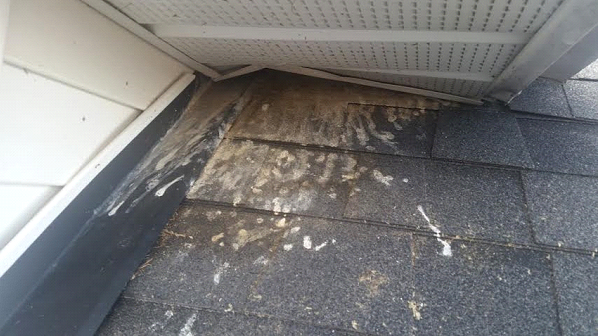
Starlings have nested in this soffit and their droppings have stained the shingles below.
At Skedaddle Humane Wildlife Control, we have various techniques to deter and exclude starlings, depending on the home or business’s needs. These methods include bird wire, netting, spikes, steel screening and exclusion sealant- applied to cracks and crevices to exclude smaller birds from entering attics and soffits.
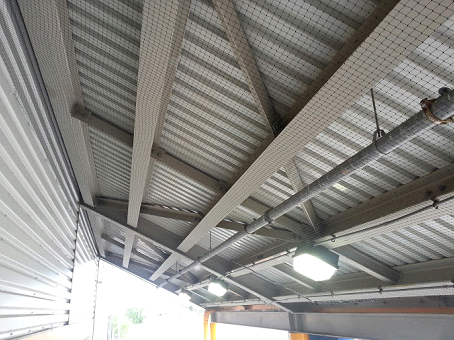
Bird netting was utilized in this warehouse to deter Starlings
Skedaddle Humane Wildlife Control has extensive knowledge in bird biology and behaviour, so we can develop a plan that fits the unique situation at your property.
Prevention and exclusion methods are always the preferred option when it comes to dealing with birds. It is much easier to seal up any cracks or crevices or screen a chimney, before the starlings have built a nest or laid their eggs, as opposed to after.
Now is the time to prevent and exclude birds from nesting on your property. Call Skedaddle today: 1.888.592.0387.
Proudly serving: Milton, Oakville, Burlington, Hamilton, Niagara Falls, Kitchener, Cambridge, Sudbury, Ottawa, Montreal, Halifax, Waterloo, Guelph, St. Catharines, Mississauga, Brampton
